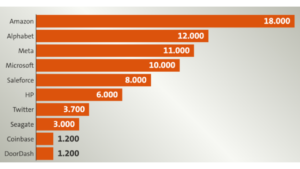“Thank you for working so hard to help people and businesses everywhere. Your contributions have been invaluable, and we are grateful,” Alphabet CEO Sundar Pichai wrote in a recent email to his employees. These bittersweet words were the prelude to devastating news for thousands of employees at the company: Their jobs have been eliminated with immediate effect. The warm words may have been little consolation for the 12,000 “Googlers” – as Pichai calls them – who have lost their jobs.
Cutbacks at US tech companies: 12,000 layoffs at Alphabet, 18,000 more at Amazon
Recently, press reports of this kind have been pouring in. Despite profits in the billions (according to Börsenblatt Amazon net profit 2021: 33.4 billion dollars, up 56.8% on the previous year), leading global tech players are making cuts – the wave of layoffs is rampant. Who will be hit next? This is a question that mainly confronts workers in the tech industry. The following chart reflects how the planned job cuts of the US tech giants look:
Number of jobs that were cut

Source: tagesschau.de As of 20/01/2023, absolute figures
What is behind the wave of layoffs?
The mutually trumping terrible news in the economic news cement this impression once more. In short, it is a real shame! Apparently. Even though it cannot be denied that we are in difficult times, both economically and socially: If even industry leader Zalando is cutting hundreds of jobs, is the German tech industry perhaps facing a fate similar to that of the American?
But let’s take a closer look: for Germany alone, the employment situation at the beginning of 2023 looks downright rosy. Never have there been so many employment relationships in the Federal Republic of Germany as in January 2023. Although Germany has been struggling with an energy crisis, high inflation and a shortage of materials since last year, the number of people at work reached a record level, as the Federal Statistical Office reported. The number of employed people rose by 589,000 or 1.3 per cent to about 45.6 million. This level was the highest since the reunification of Germany in 1990. The previous high of 45.3 million employed people was exceeded by about 292,000 in 2019.
The decline in the Corona period
In 2020, the Corona crisis interrupted the 14-year increase in the number of people in employment. There was a decline of 362,000 or 0.8 per cent. In 2021, employment increased slightly, by 65,000 persons or 0.1 per cent.
On the other hand, a look at Germany’s labour market continues to inspire confidence – despite the pandemic, the war in Ukraine or the effects of Brexit. The German labour market is stable, as the following chart impressively shows:

Source: Frankfurter Allgemeine Zeitung, January 2023, Employees in millions
Germany: More employed than ever before
However, the good news from the labour market for Germany should be clear about the possible effects of the wave of redundancies in the USA. After all, the first European tech company has now also hit the cost brakes: Spotify is putting 6% of its global workforce, 600 in number, out the door – “In hindsight, I know I invested too ambitiously compared to revenue growth,” Daniel Ek, CEO of Spotify, is quoted as saying.
But even DAX company SAP from Walldorf in Baden-Württemberg (profit 2021: 5.4 billion euros) is cutting 3,000 jobs! So, it’s only understandable that employees of tech companies here, in particular, are sweating with anxiety: Will the effects of the US wave of layoffs spread further here? But first things first. Let’s take a closer look at the employee numbers of US companies. After all, Corona has just given e-commerce an unprecedented boost in sales in 2020 and 2021!
Reasons for staff reductions
The reasons for the many job cuts can be traced back to the current poor economic situation caused by high inflation, interest rates and recession worries. Even though the technology industry is primarily “to blame” for the large wave of layoffs, it has been overly optimistic and predominantly focused on solid growth lately. Microsoft made gains on the stock market every year between 2012 and 2022, with its shares up about 59 per cent in 2019 and 65 per cent in 2021, and Google parent Alphabet’s shares rose more than 80 per cent in 2021. Other tech companies showed similar growth before plummeting abruptly in 2022.
As a result, technology companies have created thousands of jobs recently to keep up with the rapid growth and optimistic forecasts. Thomas Lehr, a capital market strategist at asset manager Flossbach von Storch, also attributes this to the extraordinary boom caused by the pandemic. Digitalisation continues to advance, but at a different pace than during the height of the pandemic.
However, the tech industry expected the strong growth to continue. Since 2019, Microsoft has grown its workforce by more than 77,000 employees to 221,000. Facebook parent Meta added more than 27,000 employees from 2019 to the end of 2021, and Amazon’s workforce more than doubled over the same period to 1.6 million global employees at the end of 2021. Apple’s workforce increased from 137,000 to 154,000 over the same period, but at a different pace than other companies. And it is nothing new that rapidly expanding start-ups hire more employees to be prepared for further expansion. If the hoped-for growth stagnates, the additionally hired employees become an “avoidable cost factor” – inevitably, they will have to be parted with.
Is the wave of layoffs just media hype?
Even if this deliberately sober and technocratic view does little to console the fact that the sword of Damocles hangs over the heads of workers in the tech industry and threatens to throw their economic existence off track, relativising the situation is, therefore, more than inappropriate! Nevertheless, one question inevitably arises after analysing the actual figures – viewed in context: Who or what benefits from these media-effective headlines? Of course, layoffs of these dimensions are dramatic, and this is not meant to be trivialised. The answer to this question is complex and, depending on one’s perspective, will probably be extremely diverse.
At the bottom line, staff growth despite layoffs
The figures that Scott Galloway, professor of marketing at New York University (NYU), published on his LinkedIn page at the beginning of 2023 put the current labour market situation in a different light: If one considers the massive staff increases that took place during the pandemic, the mass layoffs of the last few weeks still mean an increase in employees in terms of absolute numbers.
For example, out of 77,000 new employees hired during the pandemic, “only” 10,000 had to leave the company during the downsizing. The graph below illustrates this once more:

Hiring, Q4 2019 – Q3 2022, Layoffs – 2023 Yahoo Finance, Bloomberg, Layoffs, FYI, Company data
NYU marketing professor Scott Galloway provides further insight into “The Rise and Fall of the Big Tech Companies” in the following video clip:
Copycat effect – Another reason for layoffs?
With established and storm-tested – and liquid – companies, one should be able to assume a certain resilience; short-term volatility should, therefore, not be reflected in the number of employees, especially since the mass layoffs would create a specific copycat effect, a “social contagion”, in the companies, according to Prof. Jeffrey Pfeffer, a renowned professor at Stanford University.
“Companies are imitating each other,” he said in an interview with a university newspaper. “Apart from that, it doesn’t do much good for the morale and motivation of the remaining employees,” Pfeffer continued. Furthermore, He is sure that the performance after company crises would be better if they had not fired anyone.
It remains exciting. On the one hand, qualified staff who are desperately sought elsewhere are being laid off, including in Germany; there still seems to be much room for improvement, especially in designing new workplace concepts. How can these needs of employees and employers be better networked in the future – also internationally?
Since the lack of skilled workers in the IT sector will remain one of the central problems of the German economy, demographic problems aside, a certain perplexity remains. In November last year alone, 137,000 jobs were unfilled throughout Germany. Moreover, the late baby boomers will be missing from the labour market in the upcoming years as they retire. By the mid-2030s, the number of people of retirement age (67 and over) in Germany will increase by about 4 million to at least 20.0 million.
Here, politics is called upon to finally open up real prospects in the EU with practicable, low-threshold migration concepts, top talents and qualified, well-educated people and finally address legal immigration seriously.
It, therefore, remains to be seen whether the trend, which is not a trend, will continue in Germany. Nevertheless, it is not without a certain humour that the Minister of Labour, Hubertus Heil, called on companies on 17 February 2023 to make use of nimble senior citizens because the shortage of skilled workers threatens to paralyse entire industries.







